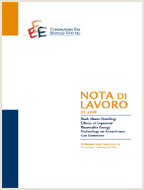Alternative Paths toward a Low Carbon World

01.05.2010
Valentina Bosetti, Carlo Carraro, Massimo Tavoni
C72, H23, Q25, Q28
Climate Policy, Stabilization Costs
Climate Change and Sustainable Development
Carlo Carraro
This paper analyzes the economic and investment implications of a series of climate mitigation scenarios, characterized by different levels of ambition in terms of long term stabilization goals and the transition to attain them. In particular, the implications of fairly ambitious scenarios are investigated for the first time by means of the model WITCH. Although milder climate objectives can be achieved at moderate costs, our results show that stringent stabilization paths, compatible with the target of the European Union and the G8, might have important economic repercussions. The timing of mitigation action influences the cost of meeting a target as well the stringency of the targets we can aspire to. To contain costs it is crucial to rely on a wide mitigation portfolio. Strong reductions in energy consumption through enhanced energy efficiency and life style changes are needed to achieve stringent climate policies. The analysis carried out in the present paper contains several idealistic assumptions that could be violated in the real world where some technologies may not be fully available, technology transfers and diffusion are imperfect, some world regions may not accept to reduce their GHG emissions, trading might be limited to some sectors or to a fraction of the total abatement effort, etc. This would increase the challenge of climate protection and the costs of reducing GHG emissions.
***
Suggested citation: Valentina Bosetti, Carlo Carraro, Massimo Tavoni, Timing of Mitigation and Technology Availability in Achieving a Low-Carbon World, Environmental and Resource Economics, Volume 51, Issue 3, pp 353-369, http://rd.springer.com/article/10.1007%2Fs10640-011-9502-x
